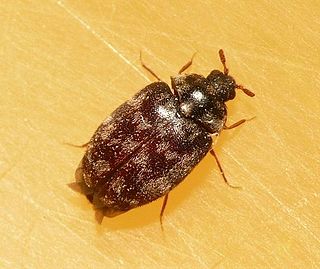
Sulconazole is an antifungal medication of the imidazole class. It is available as a cream or solution to treat skin infections such as athlete's foot, ringworm, jock itch, and sun fungus. Although not used commercially for insect control, sulconazole nitrate exhibits a strong anti-feeding effect on the keratin-digesting Australian carpet beetle larvae Anthrenocerus australis.

Anthrenocerus is a genus of beetles in the family Dermestidae, the skin beetles.
Anthrenocerus armstrongi is a species of beetle, native to Australia. It is within the Anthrenocerus genus, and the family Dermestidae.
Anthrenocerus arrowi is a species of beetle, native to Australia. It is within the Anthrenocerus genus, and the family Dermestidae

The Anthrenocerus australis is a species of beetle belonging to the dermestidae family. It is commonly known as the Australian Carpet Beetle and is one of the most researched of the thirty-one species in the Anthrenocerus genus. This is generally attributed to its prevalence throughout Australia and New Zealand and the negative economic and agricultural impact it has as a pest. It is the larvae that causes damage to products, not the adult beetle. The total life cycle of this insect is around three years, most of which is spent as a larva. Once the beetle reaches maturity, it only lives for between two and six weeks.
Anthrenocerus bicolor is a species of beetle, native to Australia. It is within the genus Anthrenocerus and the family Dermestidae.
Anthrenocerus condensus is a species of beetle, native to Australia. It is within the genus Anthrenocerus and the family Dermestidae.
Anthrenocerus confertus is a species of beetle, native to Australia. It is within the genus Anthrenocerus and the family Dermestidae.
Anthrenocerus convexus is a species of beetle, native to Australia. It is within the genus Anthrenocerus and the family Dermestidae.
Anthrenocerus decoris is a species of beetle, native to Australia. It is within the genus Anthrenocerus and the family Dermestidae.
Anthrenocerus hirsutus is a species of beetle, native to Australia. It is within the genus Anthrenocerus and the family Dermestidae.
Anthrenocerus intricatus is a species of beetle, native to Australia. It is within the genus Anthrenocerus and the family Dermestidae.
Anthrenocerus micus is a species of beetles, native to Australia. It is within the genus Anthrenocerus and the family Dermestidae.
Anthrenocerus nebulosus is a species of beetles, native to Australia. It is within the genus Anthrenocerus and the family Dermestidae.
Anthrenocerus pilatus is a species of beetles, native to Australia. It is within the genus Anthrenocerus and the family Dermestidae.
Anthrenocerus pinto is a species of beetles, native to Australia. It is within the genus Anthrenocerus and the family Dermestidae.
Anthrenocerus schwarzeneggeri is a species of beetles, native to Australia. It is within the genus Anthrenocerus and the family Dermestidae. It is native to New South Wales It is named after Arnold Schwarzenegger.
Anthrenocerus stigmacrophilus is a species of beetle, native to Australia. It is within the genus Anthrenocerus and the family Dermestidae.
Anthrenocerus terzonatus is a species of beetle, native to Australia. It is within the genus Anthrenocerus and the family Dermestidae.
Anthrenocerus trimaculatus is a species of beetle, native to Australia. It is within the genus Anthrenocerus and the family Dermestidae.


